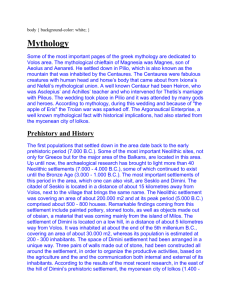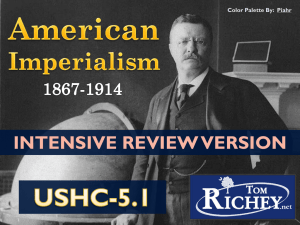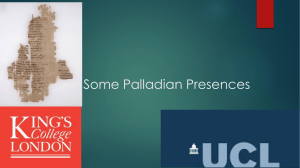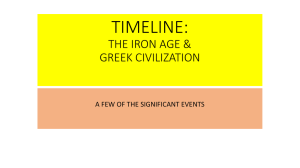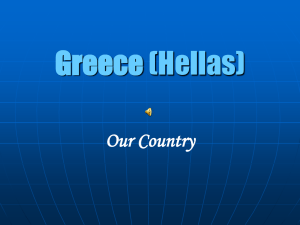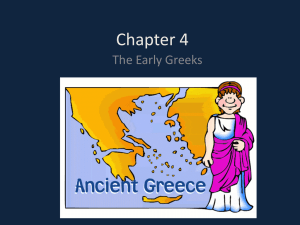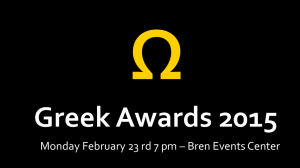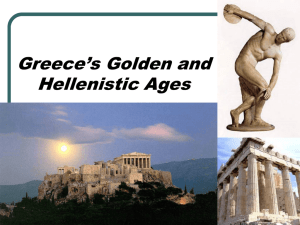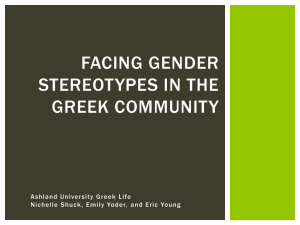Monuments of the city
advertisement
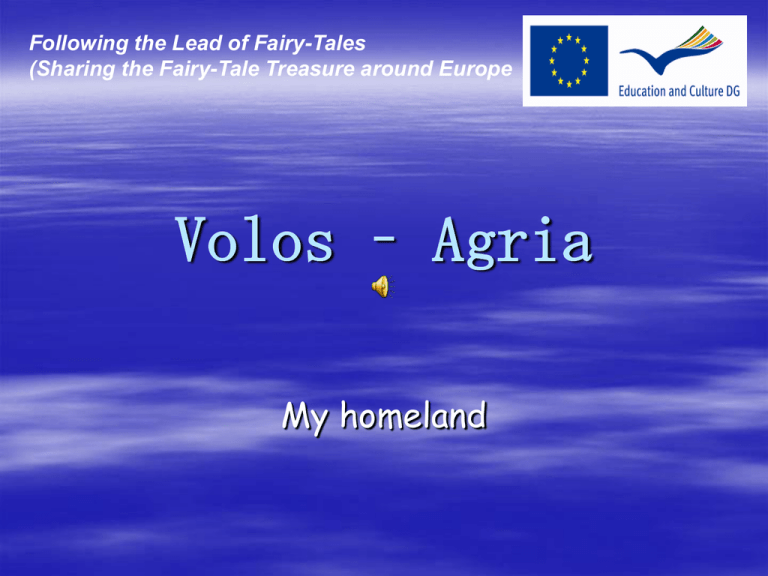
Following the Lead of Fairy-Tales (Sharing the Fairy-Tale Treasure around Europe Volos – Agria My homeland Location Volos (Βόλος) is a coastal port city in Thessaly (green part of the maps) situated midway on the Greek mainland, about 326 Km north from Athens and 215 Km south from Thessaloniki. Location Volos is the capital of the Magnesia prefecture. Agria is on the outskirts of Volos. It is situated 7 Km southeast from Volos. Population Volos has a population of around 141.675 inhabitants. It is the fifth largest city of Greece. Volos has more than 65% of Magnesia’s population today. Agria has about 6.500 inhabitants and it is the local municipality in Volos with the highest population growth in the recent decades. Emblem of the city The Emblem of the city is the Argo. In Greek mythology, the Argo was the ship on which Jason and the Argonauts sailed from Iolkos to Colchis (a port in Black Sea) to retrieve the Golden Fleece. It was named “Argo” after its builder, Argus. Districts of the city After the last administrative division Volos in 2011 is the sixth most populous municipality in Greece. It consists of the following local municipalities: conurbation of Volos, New Ionia, Agria, Artemida, Aeson, New Anchialos, Iolkos, Portaria and Makrinitsa (photo). Horizontal and Vertical Unbundling Volos is built at the innermost point of the Pagasetic Gulf (photo) and at the foot of Mount Pelion (height of 1.624 meters, the land of the Centaurs). Volos is the only outlet towards the sea from Thessaly, the country’s largest agricultural region. Climate Volos, as a Mediterranean city, experiences a typical climate of neither particularly high nor extremely low temperatures throughout the year. In summer the temperature reaches 35 0C and in winter it is reduced to about 0 0C. The climate of Volos is one of a low humidity. There is a normal distribution of rainfall throughout the year. The dry season lasts about two months during the summer. Flora and Fauna In the area of Volos and Agria there are the most species of Mediterranean flora. Mostly, however, there are olive trees, pear trees, apple trees, chestnut trees (photo), pine trees and large areas with glass-houses with ornamental plants. The fauna consists of domestic animals, foxes, squirrels, turtles and snakes Economy of the city - Occupations of the Habitants Volos is an important industrial center. Its port provides a “bridge” between Europe, the Middle East and Asia. The economy of the city is based on manufacturing, trade, services and tourism and with its improved infrastructure the city is increasingly dynamic. (photo: Cement factory in Agria) The city represents a fully urbanized Greek city with a large population in tertiary employment (52%), 42% in secondary and less than 6% in primary employment. History of Volos The Neolithic settlements of Dimini and Sesklo lie on the west part of the modern city of Volos In Dimini there are ruins of the walls of an acropolis and two beehive tombs dating in between 4000-1200 BC (in photo the ruins of settlement and a representation of it) In Sesklo there are the ruins of the oldest Acropolis in Greece (6000 BC) and also the foundations of a palace and mansions, among its most characteristic examples of Neolithic civilization. History of Volos During the Mycenaean Period (1700-1000 BC), ancient Iolkos was founded in Dimini area, which was the most important economic and cultural centre of the time. Iolkos was the homeland of the mythological hero Jason (photo: the man on the right), who board the ship “Argo” accompanied by the Argonauts and sailed in quest of the Golden Fleece to Colhis. During the Classical period (6th century BC) the town of Pagases “flourished” in the area. It was the port of Feres (now the town of Velestino) and it was founded in the place of Pefkakia (seaside suburb of the city of Volos). History of Volos At 295-92 BC, the Macedonian king Dimitrius the Besieger, one of the successors of Alexander the Great, founded and named a city after him in the foot of mountain Pelion. Dimitriada became a powerful military station of the Macedonians, and a strong trading centre of the Hellenistic times, and especially between 217-168 BC. In 1423 the Turks occupied the castle of Dimitriada. Gradually, In 197 BC, the Romans occupied Dimitriada. the coastal towns were abandoned, and around 1600 the last Greek residents of the town moved to Pelion and founded twenty four villages. (photo: The theatre of Dimitriada) History of Volos During the Turkish occupation, the financial and cultural activities took place in mountain Pelion. Through the 18th century, Pelion evolved into one of the most significant centres of the Greek region, yet the entry of Christians inside the fort of Volos (a new name for Dimitriada) remained forbidden. (photo: manor house in the village of Pelion. It was built in the period of Turkish occupation) By 1881 (2th of November), after the Constantinople Convention, Volos and the wider Magnesian territory joined the recently liberated Greek state. History of the city After 1881 the expansion of Volos was fast. Fulfilling all the necessary requirements relating to investor capitals, manpower, expansive local market force, raw materials, Volos turned out to be a robust industrial city. The most lucrative businesses included metallurgy, tobacco, textiles, tannery and food supplies. The port of Volos supported these activities very well (photo). Between 1941 and 1994 German and Italian troops occupied the city of Volos. But this did not halt the industrial and economic development of the city. Nor a terrible earthquake in 1955 which caused significant damage in most of the houses (photo). History of Agria Agria was created in the early 19th century. It had small huts inhabited by 17 residents of the villages of Pelion, when they harvested their olives. They traded their products from the small port of Agria. After liberation from the Turks Agria developed commercially. There were large warehouses in the town. The most important of the products of Pelion were handled by the port, which was the most important in Magnesia in the early 20th century. History of Agria There was a high population growth in Agria after the earthquake of 1955. Nowadays more and more people leave the urban environment of Volos and settle in the area. Today Agria is a modern seaside town, “full of life” throughout the year. Its inhabitants are engaged in farming, are employed in tourism, many of them work in industries in the region. The town has many restaurants, bars and cafes, which in summer are filled with tourists and visitors. Historical / Famous Persons from VolosAgria Rigas Fereos (Velestino Magnesia's 1757 – Belgrade 1798) - Writer. He was the forerunner of the Greek War of Independence. Through his literary work he incited all enslaved peoples of the Balkans into a revolution against Ottoman Empire. His vision was a Balkan federation of free nations. For this purpose, he travelled to Europe (Bucharest, Vienna, Trieste) and organized secret revolutionary groups. He was arrested and murdered by the Turks at Belgrade. He is displayed in the currency of ten cents. He said: “… one hour of free life is better, than forty years of slavery and prison...” Historical / Famous Persons from VolosAgria Anthimos Gazis (1758-1828) was a scholar, a philosopher during the Greek Enlightenment, a cartographer and one of the heroes of the Greek War of Independence against the Ottoman Empire (first photo). Gregory Konstantas (Milies Pelion, 1753 - Milies Pelion, 1843) was a Greek scholar, priest and an important personality in the pre-revolution movement of the Greek Enlightenment (second photo). Historical / Famous Persons from VolosAgria Theophilos Hatzimihail (18701934), Known simply as Theophilos, was a major folk painter of Neo-Hellenic art. The main subject of his works are Greek characters and illustration of Greek traditional folk life and history (in picture: The Greek hero Ath. Diakos). He settled in city of Volos in about 1897 from Lesvos island where he was born, searching for occasional work and drawing in houses and shops of the area. Many paintings of his wall-drawings exist today. He spent most of his life in Pelion. His protector at the period was the landholder Giannis Kontos, for whom he did many works. Today the house of Kontos is Theophilos’ Museum. Historical / Famous Persons from VolosAgria Giorgio De Chirico (1888-1978) was a pre-Surrealist and then a Surrealist Italian painter. He was born in Volos where he spent the first twelve years of his life . John Hadji Argyris (1913-2004) was among the creators of the Finite Element Method (FEM) and Professor at the University of Stuttgart and Director of the Institute for Statistics and Dynamics of Aerospace Structures. Historical / Famous Persons from VolosAgria Evangelos Odysseys Papathanassiou (born in 1943 in Agria) is a Greek composer of electronic, jazz, progressive, ambient and orchestral music, under the artist name Vangelis. He is best Known for his Academy Award winning score for the film “Chariots of Fire” (1982), and scores for the films “Blade Runner” (1981) and “1492: Conquest of Paradise” (1992). In a career spanning over 49 years, writing and composing more than 40 albums, Vangelis is regarded by some music critics as one of the greatest living composers of electronic music. Historical / Famous Persons from VolosAgria Nick Mangitsis. Climber and trainer. Born in Agria in 1968, where he still lives. He is the only Greek who has climbed the highest peaks in each continent (7 summits),who has reached the North and South Pole skiing(photo), who has crossed the Sahara and crossed the Aegean Sea by kayak. He says: “We don’t do everything to become the best in the world but the best in “our” world. " (photo: Himalaya – Everest) About the name of the city/town According to a Byzantine historian of the 14th century, Volos was known as Golos. The most widely accepted theory for the derivation of the city’s name suggests that Volos is a corruption of the Mycenaean Iolkos, which had become distorted through the ages to become “Golkos”, later “Golos” and subsequently Volos. Others contend that the name originates with Folos, who according to myth was a wealthy landlord of the region. Agria was named either because of the goddess Artemis, the protector of the fields (Agrea Artemis in ancient Greek) or from the many wild (agria in Greek) olive trees which were in the area. Landscape that I love The water front of Volos – 2km for a walk Landscape that I love Mountain Pelion Sports The most popular sports in Volos are football and basketball. But the city has a tradition in rowing and water polo. The men's soccer team “Olympiakos Volou” (photo) struggling in the Premier League. In women, the football team "Volos 2004" (photo) is the favorite to win the Greek championship this year, while the basketball team struggling to stay in the Premier League. Sports Vasilios Polymeros is a Greek rower. He was born in Volos in 1976. He won the bronze medal in men’s lightweight double skulls with Nikolaos Skiathitis (also an athlete from Volos) at the 2004 Summer Olympics in Athens (second photo) and the silver medal in men’s lightweight double skulls with Dimitrios Mougios at the 2008 Summer Olympics in Beijing (first photo). Monuments of the city The University of Thessaly was founded in 1984. The University is based in Volos, but operates corpuses in Larissa, Trikala and Karditsa, other cities in Thessaly. The University comprises four faculties – Humanities, Engineering, Agricultural Sciences and Health Sciences. (photo: This building in Volos Beach houses now the Administration of University of Thessaly. Originally was the Tobacco Warehouse "Papastratos" and was built in 1926) Monuments of the city The steam driven brick factory “Tsalapatas”. It was built in 1925 under the instruction of Belgian engineers aiming to the production of bricks and tiles. Today the factory does not work (it stopped in 1975). Nowadays it includes the Museum of Brickworks “Tsalapatas”, restaurants, pubs and music scenes in it. Monuments of the city The Neoclassical building of the Bank of Athens (also known as Bank Kosmadopoulos) is one of the few historic buildings of the city which were not destroyed during the earthquake of 1955. Today it is the Library of the University of Thessaly. Monuments of the city The Railway Station of Volos was built in the late 19th century (photo ). The Railway Museum is on the first floor of the building houses (photo). Monuments of the city The Archaeological Museum of Volos was built in 1909 with money provided by Alexis Athanasakis, to be stored in this written tombstones which were from the cemeteries of the ancient city of Dimitriada. The building is neoclassical. Monuments of the city “Panthessalikon” stadium It was built in 2004 and it was the site of football matches (first round) during the 2004 Summer Olympics. It has a capacity of 22.700 seats. It is the home stadium of Olympiakos Volou F.C. Monuments of the city The cinema 'Achilles' launched in 1925 and housed several cultural events of Volos for 65 years. Today it operates as two multiplex cinemas and entertainment venues. Monuments of the city The building of the Bank of Greece started in 1935 and is still today one of the most striking buildings that adorn the coast of Volos. Monuments of the city Volos City Hall was built in 1970 by the great architect Dimitris Pikionis, inspired by the architecture of Pelion, considering that the city of Volos is mainly determined by the atmosphere of the nearby Mount Pelion. Monuments of the city Park of St. Constantine is the oldest in the city and is the most loved area for walking.There are cafe, playgrounds and lush flower beds in it. Monuments of the city The building complex “Spirer tobacco warehouses” was built in 1926. After the Second World War it housed successively several companies marketing tobacco, the Tobacco Agency, some crafts. Today it houses the Museum of Volos, the Historical Archives of the City and Library. Monuments of the city The church of St. Nicholas, the cathedral church of Volos, was built in 1934 by A. Zahos. The particular temple with whimsical masonry, borrows elements from the Byzantine tradition, but below the aesthetics of the architect, who gave special attention to the external appearance of the building and its monumental appearance. Monuments of Agria In the area of Agria, on Anemoutsa hill, there are three quaint chapels: one of the Holy Archangels, one of the Holly Cross (photo) and one of the St. John. Monuments of Agria The factory that produces bottled beverages (EΨA) was founded in 1924 by two Greek businessmen, brothers Cosmadopoulos. It is famous throughout Greece for the lemon. Monuments of Agria The old railway station of Agria. A stop on the route of the train which operated with charcoal and served until 1971 the villages of Pelion linking them to Volos. Recipe Traditional plate in the villages of Pelion. It is based on the sausage, green peppers and tomatoes. First fry the sausage and green peppers separately. Then peel the tomatoes, cut into small pieces and put them in the pan. When the tomatoes boil, add sausage, green peppers, salt and pepper. Cover the pan and let all ingredients boil together until vegetables become tender and sauce become “thick”. We can add eggplant, which we fried first. The music of the presentation comes from the Greek composer Vangelis and it has the title “”. The students of F and C classes who cooperated for the presentation of Volos and Agria are: George Agoritsis, Nasia Antoniou, Kostas Argyropoulos, Nikos Vavalios, Filippa Grammatikou, Mirto Dramitinou, Vaso Kandila, Kostas Karaoulis, Maria Klitsogianni, Rafael Koukouselis, Maria Kostopoulou, Vasilis Makropoulos, Sabina Mastropanayioti, Giovanni Bardokou, Achilles Batras, Oltis Beido, Elleana Rebelakou, Cleo Sebitrasi, Thanos Stilianidis, Kostas Tegas, Anastasia Tzafolia, Katherine Tsalapata, Katherine Avdelarou, Panayiotis Agapitos, Sophie Akrivogianni, Maria Aretha, Nick Vassiliou, Sophia Vassiliou, Angela Gerovasili, Milltiades Zaharakis, Themis Theodoropoulos, Kostas Kolovos, Maria Kontoriga, Hara Koromila, George Kostanasios, George Makris, Chris Makropoulos, Panayiota Mastropanayioti, Nick Betsos, John Pllaha, Demetrius Rentiniotis, Athena Stilianidi, Marina Triantafillidi, Demetrius Tsalapatas, Apostolos Tsalikis, Thanasis Halkias with the help of the teachers of our school: Christina Sarri, Helen Kefala, Sophia Vassiliou, Xanthoula Danilopoulou.
